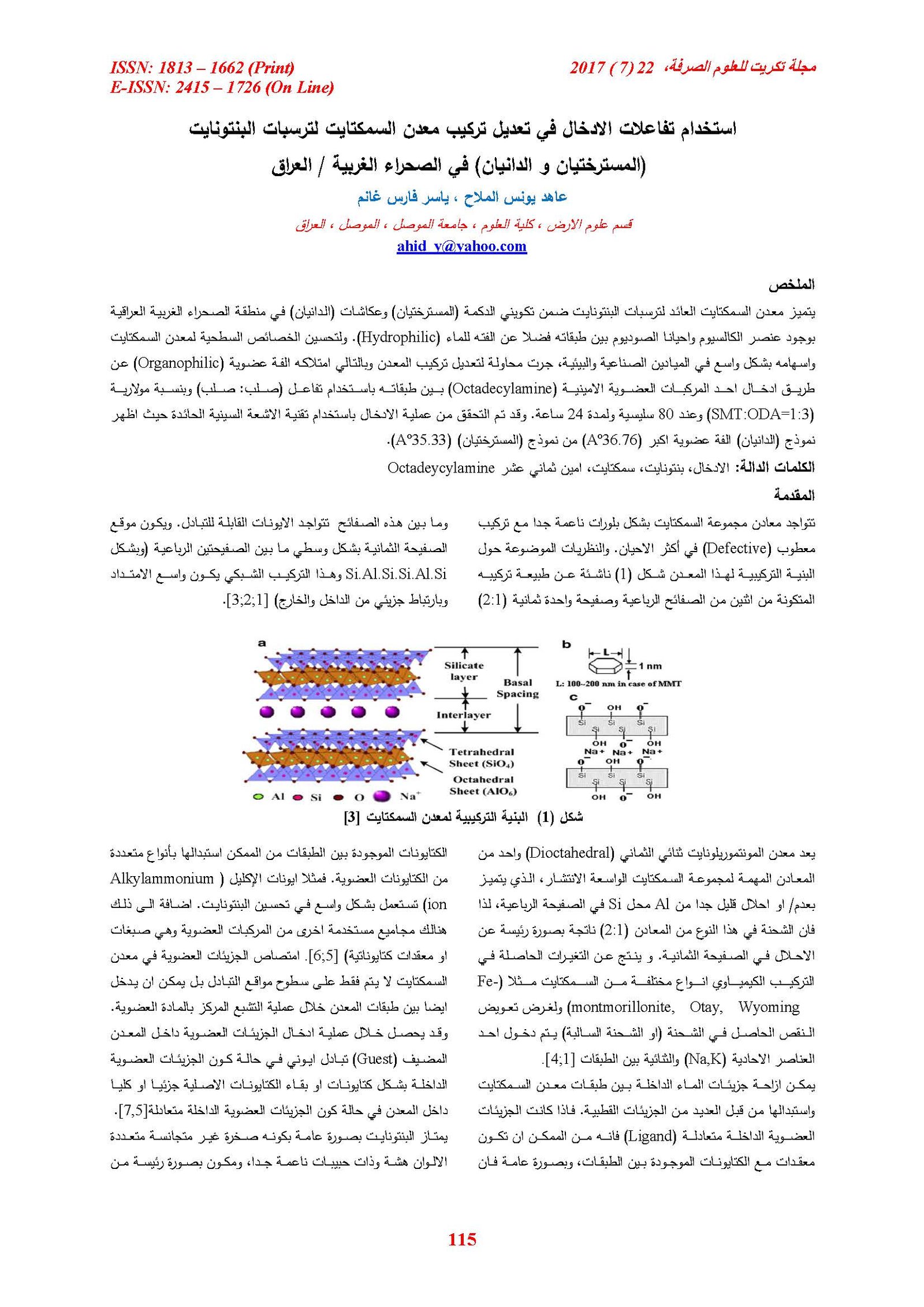Uses of intercalation reactions for modification the structure of smectite mineral of bentonite (Maastrichtian and Danian) western desert / Iraq
Main Article Content
Abstract
The smectite mineral of bentonite deposits within Digma (Maastrichtian) and Akashat (Danian) formations in the western desert of Iraq distinguished by hydrophilic properties, and the presence of Ca and sometimes Na in the interlayer space. To improve the surface properties of smectite for its contribution in industrial and environmental fields, Octadecylamine has been used for modification of smectite inorganic substance in the molar ratio of SMT:ODA=1:3 at 80 cº for 24 hr. reaction time. The intercalation confirmed by powder x-ray diffraction. The results show that the sample (T18/2) (Danian) has more organophilic than the sample (BS2C) for Maastrichtian
Article Details

This work is licensed under a Creative Commons Attribution 4.0 International License.
Tikrit Journal of Pure Science is licensed under the Creative Commons Attribution 4.0 International License, which allows users to copy, create extracts, abstracts, and new works from the article, alter and revise the article, and make commercial use of the article (including reuse and/or resale of the article by commercial entities), provided the user gives appropriate credit (with a link to the formal publication through the relevant DOI), provides a link to the license, indicates if changes were made, and the licensor is not represented as endorsing the use made of the work. The authors hold the copyright for their published work on the Tikrit J. Pure Sci. website, while Tikrit J. Pure Sci. is responsible for appreciate citation of their work, which is released under CC-BY-4.0, enabling the unrestricted use, distribution, and reproduction of an article in any medium, provided that the original work is properly cited.
References
[1] Odom I.E.(1984). Smectite clay minerals: properties and uses. Phli. Trans. R. Soc. Lond. A 311, 391-409.
[2] Brown G.(1984). Crystal structures of clay minerals and related phyllosilicates. Phil. Trans. Lond.A 311,221-240.
[3] Motawie A.M., Madany M.M., El-Dakrory A.Z., Osman H.M., Ismail E.A., Badr M.M., El-Komy D.A., D.E. Abulyazied D.E. (2014). Physico- chemical characteristics of nano - organo bentonite prepared using different organo-modifiers. Egyptian Journal of Petroleum 23, 331–338.
[4] Grim R.E. (1968). Clay Mineralogy . McGraw-Hill, Inc., New York, 596P.
[5] Lagaly G.(1984). Clay organic interactions. Phli. Trans. Lond.A311,315-332.
[6] Lagaly G., Ogawa M. and Dekany I.(2006). Clay mineral organic interactions in: Bergaya F., Theng B.K.G. and Lagaly G.(2006). Hand book of clay science.1st ed. Oxford: Elsevier,1224p.
[7] Fusova L.(2009). Modification of the structure of Ca- montmorillonite. Geoscience Engineering vol Lv, No.1 p27-32.
[9] Zainal Y. and Jarjees S. (1972). Geological report on Qara Tappa bentonite. Geosurv, int.rep.no.546.
[10] Zainal Y. and Jarjees S.(1974). Preliminary geological report on zarloukh clay (bentonite) prospect. Geosurv,int.rep.no.578.
[11] Al-Bassam, K. and Al-Sa’adi, N., (1985) Anew discovery of montmorillonite clay deposit in Iraq Jour. Geol. Soc. Iraq vol. 18,p.218-229.
[13] Al-Bassam, K. and Al-Saeed, L., (1989) Mineral investigation of the upper cretaceous safra montmorillonite claystone deposit, Horan –Traifawi area, w. desert, Iraq. Geosurv., int. rep. no. 1813.
[14] Al-Bassam, K., Mohammed, G. and Saeed, L., (1989) Detailed mineral investigation of high-grade montmorillonite claystone deposit, Horan –Traifawi area, W. Desert. Geosurv, int.rep.no.1813
[15] Zapata P., Quijada R., Returet J., Moncada E.(2008). Preparation of nanocomposites by in situ polymerization. J. Chil. Chem. Soc., 53,1369-1371
[16] Kim J., Oh T. and Lee D.(2003). Preparation and characteristics of nitrile rubber (NBR) nanocomposites on organophilic based on organophilic layered clay .Polym Int. 52: 1058-1063
[17] Chieng, B.W., Ibrahim, N.A., and Wan Y., W.M.Z. (2010). Effect of organo-modified montmorillonite on poly(butylenes succinate)/ poly(butylenes adipate – co - terephthalate) nannocopmposites. Express Polymer Letters Vol. 4,No.7(2010) 404-414
[19] Al-Bassam, K.S. (2007) Mineral resources. Iraqi Bull. Geol. Min. Special Issue , p 145-168.
[20] Bergaya F., Theng B.K.G. and Lagaly G.(2006) Hand book of clay science.1st ed. Oxford: Elsevier,1224p.
[21] Weiss, Z. & Kutvart, M. (2005). Jílové minerály: jejich nanostruktura a využití. 1st ed. Praha: Karolinum, 2005. 281 p. ISBN 80-246-0868-5.
[22] Weiss, Z., Valaskova, M., Kristkova, M., Capkova, P. and Pospisil, M.(2003).Intercalation and Grafting of Vermiculite with Octadecylamine Using Low-Temperature Melting. Clays andClay Minerals, 5, 555-565.
[23] Pospisil, M., Capkova, P., Weiss, Z., Malac, Z., Simonik, J. (2002). Intercalation of Octadecylamine into Montmorillonite: Molecular Simulations and XRD Analysis. Journal of Colloid and Interface Science. 2002, vol. 245, no. 1, p. 126-132.
